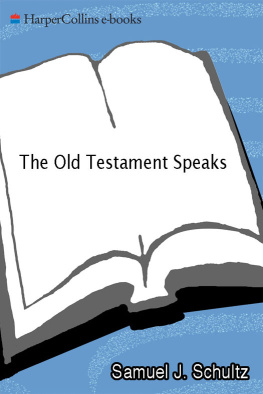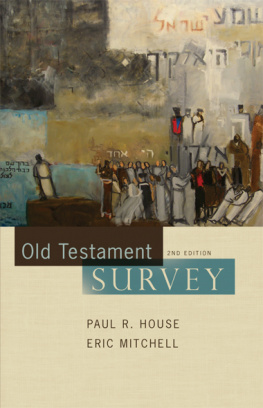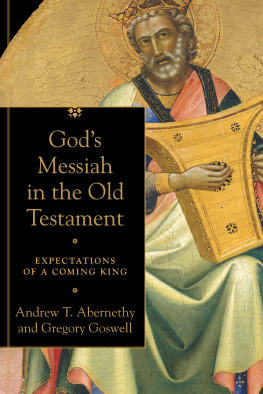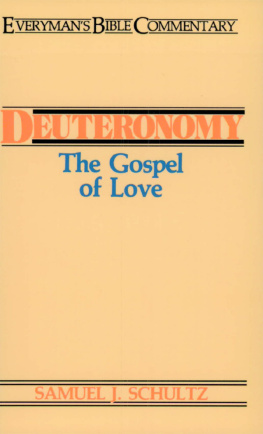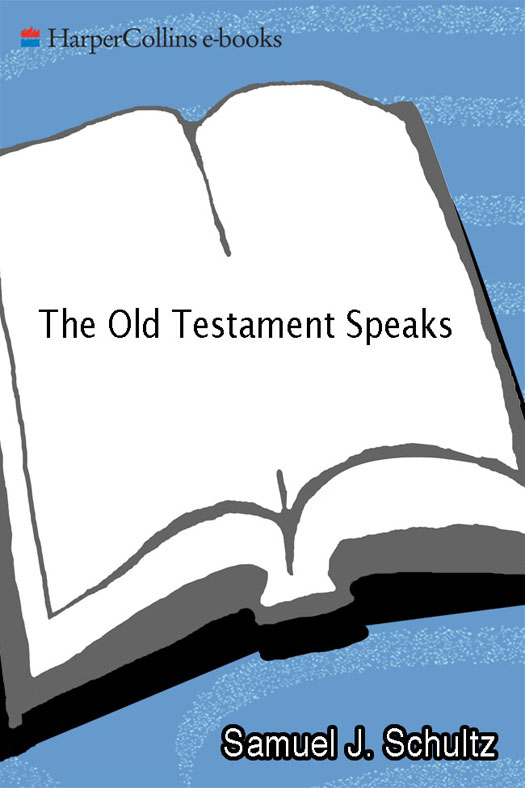
To my wife EYLA JUNE
Contents
The Ancient Near East
The Topography of Palestine
The Bible lives today. The God who spoke and acted in times past confronts men of this generation with the written word as preserved in the Old Testament. Our knowledge of ancient cultures in which this record originated has been greatly increased through archaeological discoveries and the advancing frontiers of biblical scholarship. The preparation of this survey, designed to introduce the liberal arts student and lay reader to the history and literature of the Old Testament, has been prompted by more than a decade of classroom experience. In this volume I endeavor to offer an outline of the entire Old Testament in the light of contemporary developments.
In my graduate studies I was exposed to a wide range of Old Testament interpretation under the late Dr. Robert H. Pfeiffer at Harvard University as well as Drs. Allan A. MacRae and R. Laird Harris at Faith Theological Seminary. To these men I am indebted for a critical understanding of the basic problems confronting the Old Testament scholar. It is not without an awareness of the conflict in contemporary religious thought regarding the authority of the Scriptures that the biblical view of revelation and authority is projected as the basis for a proper understanding of the Old Testament (see Introduction). Since this analysis is based on the literary form of the Old Testament as it has been transmitted to us, questions of authorship are only occasionally noted and pertinent facts of literary criticism are mentioned in passing.
Charts are provided to aid the reader in a chronological integration of Old Testament developments. Dates for the earlier periods are still subject to reappraisal. Any dates before Davidic times should be regarded as approximate. For the Divided Kingdom I have followed the chronological scheme of Edwin H. Thiele. Since the names for the kings of Judah and Israel constitute a problem for the average reader, I have given the variants as used in this book on pages 160162.
Maps are designed to aid the reader in a better understanding of the geographical factors as they affected contemporary history. Boundaries changed frequently. Cities were destroyed and rebuilt in accordance with the varying fortunes of the kingdoms which rose and fell.
It is a pleasure to acknowledge my debt of gratitude to Dr. Dwight Wayne Young of Brandeis University for reading this manuscript in its entirety and offering helpful criticism throughout. I wish also to express my appreciation to Dr. Burton Goddard and William Lane of Gordon Divinity School, and to Dr. John Graybill of Barrington Bible College, who read earlier versions. Special thanks is due my friend, George F. Bennett, whose concern and counsel were a continual source of encouragement.
I wish to express my thanks to the administration of Wheaton College for granting me leave of absence to complete the manuscript, to the Wheaton College Alumni Association for a research grant, and to the South Shore Baptist Church of Hingham, Massachusetts, for providing facilities to do research and writing. I am grateful for the interest and encouragement of my colleagues in the Bible and Philosophy Department of Wheaton College, especially Dr. Kenneth S. Kantzer, who assumed chairmanship responsibilities in my absence.
To Elaine Noon I am thankful for her exacting care in typing the entire manuscript. Likewise the helpful aid of librarians at Andover-Harvard and Zion Research libraries is greatly appreciated. I am indebted to Carl Lindgren of Scripture Press for the maps in this volume.
Above all this project could not have been accomplished without the willing co-operation of my family. My wife, Eyla June, read and reread every word, offering invaluable criticism, while Linda and David graciously accepted the changes this endeavor imposed upon our family life.
S.J. S.
Wheaton College
Wheaton, Illinois
January, 1960
Preface to the Fourth Edition
For three decades this volume has provided an introductory guide to the reading and study of the Old Testament for college and seminary students, laity, and Bible-study groups, as well as for various centers for biblical education by extension. Translated into many languagesJapanese, Spanish, Portuguese, Chinese, Swedish, German, Croatian, Bulgarian, Arabic, Urdu, and othersit has had a global ministry. This has been most gratifying.
The limited revisions in this edition, primarily in the Poetical Books and Minor Prophets, reflect the interpretations and insights published in recent volumes, as indicated in the footnotes. Selected readings and bibliographies offer pastors, as well as laity, guidance for further study of the Old Testament as Gods Word.
S.J. S.
Lexington, Massachusetts
October 1989
Preface to the Fifth Edition
The Old Testament continues to speak to us today. While the core of the Old Testament has been succinctly summarized in five wordsLove God, Love Your Neighborthe text as a whole delineates Gods revelation of himself in expressing his love for the human race (cf. Mtt. 22:3738).
When God completed his work with the creation of humankind, He entrusted them with the responsibility of ruling over all that He had created. When this relationship was severed, divine judgment followed; however, Gods mercy preceded His judgment as exemplified in His love and care for the human race (Gen. 111).
As early as the days of Abraham, God had already chosen the Israelites as his special people (Deut. 4:37). God revealed himself to Israel, designating them to be a kingdom of priests to all humankind (Ex. 19:56). After displaying his mighty power in freeing the Israelites from Egyptian enslavement, God revealed himself through Moses at Mount Sinai. Later, Moses solemnly reminded them of their unique and awesome experience when they heard God speak (Deut. 4:3238). Throughout all their desert wanderings, they experienced Gods love and gracious care at all times (Gen. 12 to Deut. 34).
God continued to display His mighty acts to the Israelites as they conquered and occupied the promised land, and He enabled them to establish a powerful kingdom under David. God used prophet after prophet to warn the Israelites that they had broken their relationship with God (cf. Isa. 1:4; Jer. 2:13) and to admonish them to return to One who was gracious and merciful (cf. Isa. 55). I have loved you is Gods message through Malachi, the last prophet in Old Testament times.
This revelation of Gods plan culminated in His sending to earth Jesus Christ, His only Son, to minister, to die, and to be raised from the dead. Through Jesus salvation was offered to all humankind (Jn. 3:16).
The Old Testament Speaks has continued to extend its global outreach. In addition to those languages listed in the preface to the fourth edition, it is now available in Czech, Hungarian, Polish, Romanian, Korean, Russian, Georgian, Thai, and Yugoslavian.
This fifth edition offers a current bibliography designed to guide the reader into an appreciation of the Old Testament as a record of Gods revelation. For assistance in the selection of these volumes, I am indebted to Dr. Gary Pratico and his colleagues, Drs. Duane Garrett and Douglas K. Stuart, at Gordon-Conwell Theological Seminary.
The authors hope and prayer for this fifth edition is that the reader will be stimulated to a greater love for God and His message as recorded in the Old Testament.
S.J. S.
Lexington, Massachusetts
Next page
